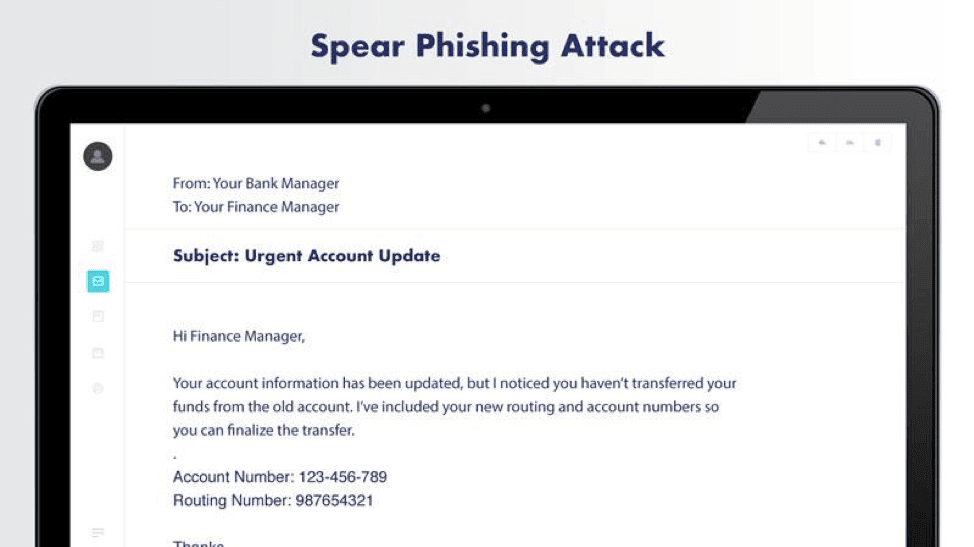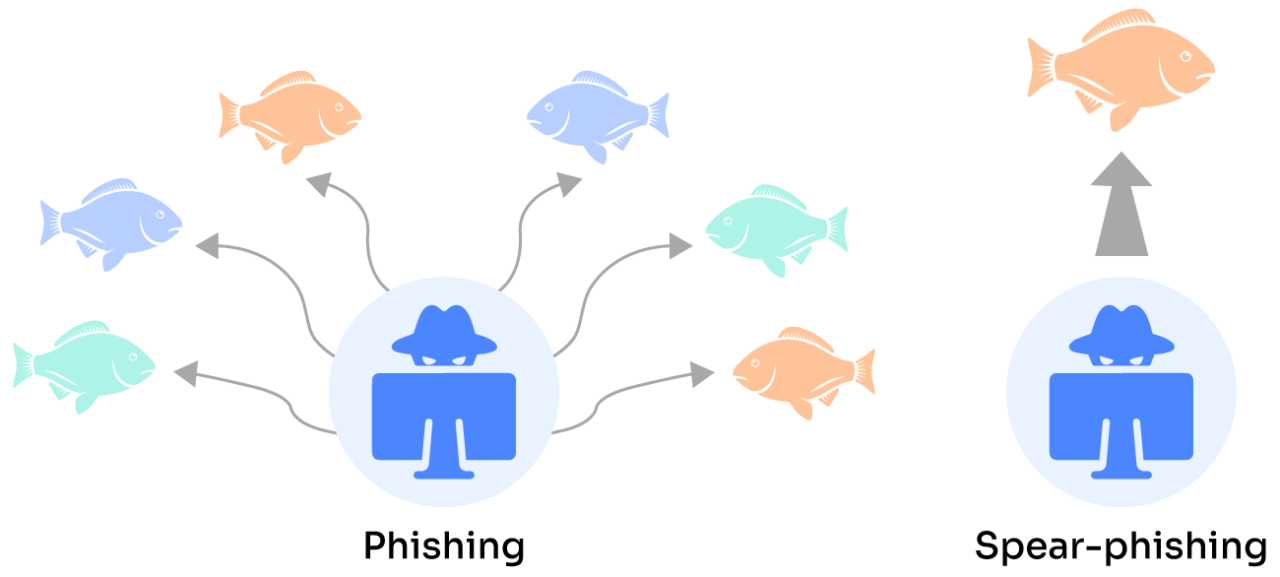What are the differences between spear phishing vs. phishing? Phishing (and spear phishing, for that matter) isn’t a new concept for internet users. Scams have slipped into inboxes for years—some promising outrageous riches, others wielding cleverly-worded incentives.
According to the FBI, in the last 9 years, $50 billion was the reported loss to Business Email Compromise (BEC). Meanwhile, a similar report listed spear-phishing attacks as the most popular attack vector used by observed hacker groups.
Phishing and spear phishing are both examples of social engineering cyber attacks. Social engineering manipulates victims into revealing sensitive information, such as passwords, social security numbers, and bank account details.
Both regular phishing and spear phishing attacks are used to spread malware, such as ransomware, through malicious links and downloads. Spear phishing attempts, however, pose a more direct cyber threat to organizations than regular phishing.
To help you prevent attacks and boost your email security, we’ve broken down the key characteristics of phishing and spear phishing below.
What is spear phishing?
Spear phishing emails are a more advanced form of phishing. Spear phishing is a specific and targeted attack on one or a select number of victims, while regular phishing attempts to scam masses of people.
In spear phishing, scammers often use social engineering and spoofed emails to target specific individuals in an organization. They may impersonate family members, colleagues, or business acquaintances.
Scammers often use social media to legitimize their requests to gain information on their target.
When contacting the target, they will address them by name and use personal facts and/or casual language. They may also use malware to gather private information.
Their primary goal is manipulating employees into revealing sensitive data or committing unauthorized actions such as wire transfers to fraudulent companies.
Scammers of this nature commonly employ two methods of attack:
- Whaling attacks: These are attacks aimed at senior executives, i.e., individuals with the power to access confidential information and (unknowingly) enable a data breach or approve a large money transfer.
- CEO fraud: Targeted attacks against junior employees where the attacker impersonates a senior authority (for example, the CEO) or other high-level colleagues. They then pressure the reader into taking unauthorized actions.

What is phishing?
Regular phishing campaigns cast a broad net, whereas spear phishing emails are a more targeted approach to cybercrime.
However, that doesn’t make regular phishing emails any less of a threat.
Phishers commonly spread their scams over email, though they may target random individuals over phone calls (“vishing” ) or text messages (“smishing”). Phishing is a volume play. Out of thousands and thousands of attempts, at least one will be successful.
However, unlike spear-phishing attackers, everyday scammers use impersonal but urgent language to manipulate readers into downloading a malicious attachment, clicking an unsafe link, or disclosing private information such as credit card details or login credentials.
Phishing can happen in many different ways, including:
- Vishing: Phishing over phone calls or downloaded internet protocols (Voice over Internet Protocol or VoIP).
- Smishing: Phishing over text messages, also known as SMS phishing. Just as with computers, hackers can infect phones with malware.
- Business email compromise (BEC): As with spear phishing attacks, general phishing attempts use spoofed or hacked email addresses to lure in victims.
- Wire transfer phishing: This form of phishing is geared towards bank transfers to fraudulent entities.
Difference between spear phishing vs phishing
While spear phishing and phishing share a lot in common, they both threaten your business with different risks—and the security measures you take to defend against them differ. Here’s an at-a-glance list of differences between spear phishing and standard phishing:

1. Attack style
- Spear Phishing: Think of spear phishing as a skilled fisher with a single line, selecting the perfect bait for a specific fish. The angler studies the fish’s habits, preferences, and environment, ensuring the lure works. This precise approach makes the catch more likely and harder for the fish to recognize as a trap.
- Phishing: On the other hand, standard phishing is like a large fishing trawler casting a wide net into the ocean. The goal is to capture as many fish as possible, without concern for the type of quality. This method is about quantity not quality.
2. Personalization
- Spear Phishing: Cybercriminals spend time understanding their target’s habits, relationships, and interests. They craft personalized messages that appear legitimate and relevant to the recipient, making the deception much more convincing.
- Phishing: Standard phishing emails lack this level of personalization. They are typically generic and sent to large groups of people. The messages might include common phrases like “Your account has been compromised” or “You’ve won a prize,” which can be easily spotted by savvy users.
3. Urgency
- Spear Phishing: These attacks often build a sense of trust over time, making the recipient feel comfortable and less suspicious. The attacker might not immediately ask for sensitive information but instead gradually gain the victim’s confidence before striking.
- Phishing: Urgency is a common tactic in standard phishing. The emails often create a sense of immediate action required, such as “Click here to update your password immediately” or “Your account will be locked if you don’t respond within 24 hours.” This urgency is designed to make victims act quickly without thinking.
4. Purpose
- Spear Phishing: The goals are usually more specific and high-stakes. Attackers might be after confidential company information, financial details, or access to specific systems. They often target high-ranking executives, finance departments, or individuals with access to valuable data.
- Phishing: The objectives are broader and usually aim to collect a range of information from a wide audience. Attackers might be looking for login credentials, credit card numbers, or personal information that can be sold or used in further attacks.
5. Prevention
- Spear Phishing: Because of its targeted nature, spear phishing can be more challenging to detect with traditional security measures. It requires more sophisticated defense strategies, such as advanced threat detection systems, employee training, and strict verification processes for sensitive requests.
- Phishing: Standard phishing can often be caught by spam filters and basic email security tools. However, user education and awareness are still important because some phishing attempts can slip through these defenses.
| Aspect | Regular phishing | Spear phishing |
|---|---|---|
| Target approach | Cast a wide net – sends thousands of emails hoping someone bites | Precise targeting – like a skilled angler choosing the perfect lure for a specific fish |
| Research effort | Minimal to none – uses generic templates and messaging | Extensive – studies the target’s behavior, connections, and preferences |
| Message style | Generic greetings (‘Dear Sir/Madam’) and cookie-cutter content | Personalized content with accurate details about the target’s life or work |
| Time investment | Quick setup, automated sending | Days or weeks of preparation for a single attack |
| Success rate | Low per email, but volume makes up for it | Much higher due to careful targeting and personalization |
7 tips to protect from spear phishing & phishing
It takes just one act to infect a computer and potentially compromise an entire organization. Fortunately, the right tools and information can thwart even the most invasive attacks. Here are a few simple steps you can take today to prevent phishing attacks of all kinds.
1. Encrypt your data
In any case, where your data or device is stolen, data encryption will ensure that the attacker cannot access or use the data.
2. Use multi-factor authentication
Multi-factor authentication is one of the best ways to ensure protection when your credentials or passwords are compromised. Attackers can only access your data if they’ve authorized entry on every single authentication channel. In almost all cases, they won’t be able to do this.
3. Authenticate your email
This best practice is meant to prevent the primary way credentials are stolen. You can authenticate your email through various methods, such as configuring DMARC, Sender Policy Framework (SPF), and DomainKeys Identified Mail (DKIM).
4. Never open a suspicious email attachment
One malicious link or attachment has the power to lock you out of your device, steal sensitive data, and delete critical files. For these reasons, it’s imperative that you read through any suspicious or even unexpected emails.
Though you may recognize the sender, it never hurts to double-check with them before opening an email attachment.
5. Keep software current and updated
By enabling automatic downloads on all applications and operations systems, users are less likely to be compromised by potential security exploits and phishing attempts.
6. Use strong passwords and regularly update them
Hackers can crack 90% of all passwords in just under six hours. Most people use recycled passwords at home and in the workplace, which poses a serious security risk.
Fortunately, users can deter cybercriminals by developing strong password habits and tools like password managers.
7. Stay up to date and follow best practices
Given the right incentives, anyone can fall prey to a phishing attack. Sharpen cybersecurity know-how with regular security training sessions and briefings. Make sure to regularly check the newest best practices as phishing tactics continuously evolve.
How DMARC safeguards your entire business
Organizations are highly encouraged to implement DMARC authorization protocols and solutions to fortify their security efforts and ensure 360-degree protection.
Domain-based Message Authentication, Reporting, and Conformance (DMARC) is the gold standard for strong email authentication. It ensures that only authorized senders can send emails using your domain and restricts unauthorized users from malicious acts such as email spoofing, phishing, and spear phishing. It’s so important that multiple federal governments, including the US, UK, and Germany, require it for all government emails.
It combines and leverages the email authentication standards SPF and DKIM. As a website or business owner, you want to ensure that all visitors or recipients will only view emails that you personally have sent or authorized. DMARC is the most effective way to completely secure your email and ensure that every email is intentional, safeguarded, and free of cybercriminal activity.

Bonus: Not only do DMARC solutions safeguard your email activity, but they can positively impact your organization’s reputation and brand. DMARC effectively protects your brand by thwarting unauthorized parties from sending malicious emails, preserving your brand’s voice and integrity.
Additionally, DMARC reports provide increased visibility and transparency into your email activity. This level of visibility allows you to identify and further prevent any suspicious acts.
Frequently asked questions about phishing
How quickly can I detect a phishing attack?
You can spot most phishing attempts within seconds if you know what to look for. Warning signs include unexpected urgency, generic greetings, spelling errors, and email addresses that don’t quite match the legitimate company. However, sophisticated attacks might take longer to identify.
Pro tip: hover over links (don’t click!) to preview the URL and check if it matches the supposed sender.
What should I do if I clicked on a phishing link?
Don’t panic, but act fast. Here’s what to do immediately:
- Disconnect your device from the internet to prevent malware spread
- Change passwords for any accounts you logged into after clicking the link
- Run a full antivirus scan
- Monitor your accounts for suspicious activity
- Report the incident to your IT team if it happened at work
- Contact your bank if you entered financial information
How do I report phishing attempts?
- At work: Forward the suspicious email to your IT security team and delete it from your inbox. Never forward phishing emails to other colleagues.
- Personal email: Forward phishing attempts to:
- Google (Gmail): phishing@gmail.com
- Microsoft: phishing@office365.microsoft.com
- US government: report@phishing.gov
- Anti-Phishing Working Group: reportphishing@apwg.org
Also report to the supposed sender’s company through their official website (not via email).
Can phishing attacks bypass 2FA?
While two-factor authentication (2FA) makes phishing much harder, determined attackers can still find ways around it. They might use real-time phishing kits that capture and replay your 2FA codes, or use social engineering to trick you into giving up both factors. That’s why it’s crucial to combine 2FA with other security measures like DMARC and employee training.
Protect your business from phishing with Valimail
Both regular phishing and spear phishing campaigns have the power to damage an organization’s credibility. The right email security can avert phishing attacks with simple protocols.
At Valimail, we provide automated DMARC configuration for organizations of all sizes, boosting deliverability rates and protecting brand integrity from spoofed emails. Valimail optimizes DMARC enforcement so organizations can rest assured, knowing only authorized senders can reach out to customers, partners, and employees.
Thanks to our user-friendly authorization tools, DNS configuration requires little to no technical expertise. Just set your authorization once and keep your domain secure forever.
In addition to added security, our easy-to-use platform provides detailed analytics and rich, real-time supplemental data to help you get the outreach you need. Protect yourself with Valimail. We’ve blocked over 8.6 billion bad actors and we get you to DMARC enforcement 4x faster than legacy DMARC vendors and 8x faster than DIY so your email is protected.


